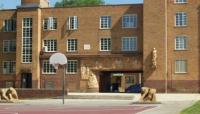Landscape Information
The 13.7-acre Langston Terrace Dwellings in northeast Washington, D.C., located between H Street, Benning Road, 21 and 24th Streets, is a remarkable example of a Modernist International Style residential complex designed and built by African Americans. It was conceived to not only provide safe and sanitary housing for the working class and the poor but aspired to uplift the spirits of its resident. The development was constructed between 1935 and 1938. Funded by the Public Works Administration (WPA) Housing Program, it was the first such development in the nation’s capital and the second in the United States. The buildings were designed by Hilyard Robinson and Paul Williams, of the firm Robinson, Porter and Williams, two celebrated African American architects who had studied abroad; the landscape was designed by David Williston, one of the nation’s first African American landscape architects. The housing complex was conceived of and built for aspiring and upwardly mobile African American families.
The rectangular site is organized around a central green with buildings containing 2, 3, and 4 stories following the terraced topography. The terraced site provided an opportunity to arrange the different building heights for optimal views inward and outward to the central green space, situated at the highest point looking out over the complex. The children’s playground contains the five reinforced cast concrete cubist animal structures, designed by sculptor Lenore Thomas and added in 1941, for climbing and playing. Approximately 20% of the site contains buildings, with 80% dedicated to communal green space and walkways. The main entrance, an underpass, decorated with a sculptured frieze by Daniel Olney, entitled the Progress of the Negro Race, is characteristic of “social realist” 1930s WPA art. The site was listed on the National Register of Historic Places in 1987.













